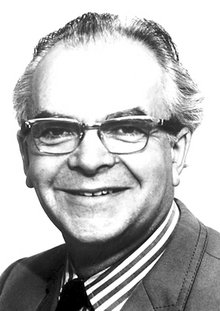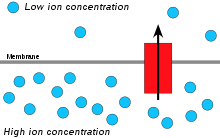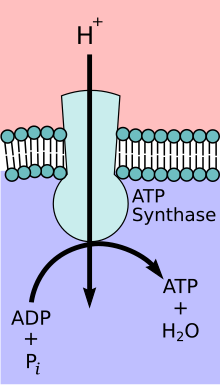Peter D. Mitchell
Peter Mitchell | |
|---|---|
 | |
| Born | Peter Dennis Mitchell 29 September 1920[1] |
| Died | 10 April 1992 (aged 71) |
| Alma mater | University of Cambridge (BA, MA, PhD) |
| Known for | Discovery of the mechanism of ATP synthesis |
| Awards |
|
| Scientific career | |
| Fields | Biochemistry |
| Institutions |
|
| Thesis | The rates of synthesis and proportions by weight of the nucleic acid components of a Micrococcus during growth in normal and in penicillin containing media with reference to the bactericidal action of penicillin (1950) |
| Signature | |
Peter Dennis Mitchell
Education and early life
Mitchell was born in
He was appointed a research post in the Department of Biochemistry, Cambridge, in 1942, and was awarded a Ph.D. in early 1951 for work on the mode of action of penicillin.[4]
Career and research
In 1955 he was invited by Professor Michael Swann to set up a biochemical research unit, called the Chemical Biology Unit, in the Department of Zoology, at the University of Edinburgh, where he was appointed a Senior Lecturer in 1961, then Reader in 1962, although institutional opposition to his work coupled with ill health led to his resignation in 1963.[3]
From 1963 to 1965, he supervised the restoration of a
Chemiosmotic hypothesis
In the 1960s,

Mitchell realised that the movement of ions across an electrochemical potential difference could provide the energy needed to produce ATP. His hypothesis was derived from information that was well known in the 1960s. He knew that living cells had a membrane potential; interior negative to the environment. The movement of charged ions across a membrane is thus affected by the electrical forces (the attraction of positive to negative charges). Their movement is also affected by thermodynamic forces, the tendency of substances to diffuse from regions of higher concentration. He went on to show that ATP synthesis was coupled to this electrochemical gradient.[10]

His hypothesis was confirmed by the discovery of
Protonmotive Q-cycle
Later, Peter Mitchell also hypothesized some of the complex details of electron transport chains. He conceived of the coupling of proton pumping to quinone-based electron bifurcation, which contributes to the proton motive force and thus, ATP synthesis.[12]
Awards and honours
In 1978 he was awarded the
References
- ^ S2CID 72791163.
- ^ doi:10.1093/ref:odnb/51236. (Subscription or UK public library membershiprequired.)
- ^ a b Antony Crofts (1996). "Peter Mitchell (1920–1992)".
- ^ Mitchell, Peter Dennis (1950). The rates of synthesis and proportions by weight of the nucleic acid components of a Micrococcus during growth in normal and in penicillin containing media with reference to the bactericidal action of penicillin (PhD thesis). University of Cambridge.
- S2CID 2073366.
- S2CID 20251582.
- ISBN 9781483199719.
- PMID 4244889.
- PMID 186667.
- S2CID 1784050.
- PMID 5220864.
- S2CID 45494306.
- ^ Peter Mitchell on Nobelprize.org , accessed 11 October 2020} including the Nobel Lecture on 8 December 1978 David Keilin’s Respiratory Chain Concept and Its Chemiosmotic Consequences
- ^ "Fellowship of the Royal Society 1660-2015". London: Royal Society. Archived from the original on 15 October 2015.
External links
- Peter Mitchell on Nobelprize.org

